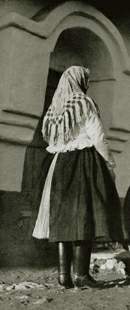Juraj Zajonc
Binding is a technique not requiring tools, because knots are tied directly with the fingers. Elements of this technique can be found in every culture. We can differentiate textile bound to a network of threads named mostly macramé, and textile bound from one endless threat (lace, net making). The method of binding as well as the shape of the knot are based on its use. Therefore specific knots or groups of knots were developed in many areas of human activities: marine, mountaineers, the surgeon’s knot used in Ancient Greece for fixing broken bones, weaving, tapestry, net-making, lace knots have their name taken from the textile technique; flat and rip knot from their shape; and also Japanese, Chinese, Turkish, and Oriental knots from their origin. When creating knot textiles, the importance of the decorative knot function gradually increased. Probably the oldest type of folded textile and ancestor for other types of embroidery are the tassels bound from a network of threads at the bottom of textile. Primarily, it strengthened the border of textile and protected it from splitting. Tassels bound from threads on the borders of towels, sheets and tablecloths are known from nearly all parts of Slovakia and had both a utilitarian and decorative function. The tassels had an exclusively decorative function for some of them. Their basis was not textile thread but an independent network of threads. These were most commonly used to decorate headscarves. Macramé as a technique for binding borders with decorative edges has its origin in the old East. Bound textiles in 19th Century Europe generally spread as a fashionable element in both the town as well as the village. A significant stimulus for the spread of the macramé technique was an encyclopaedia for housewives written by Thérése de Dillmont for D.M.C. publishers. It was first published in France, later in other languages. A new wave of interest in macramé appeared in Europe in the 1960’s and 1970’s. Individual traditional textiles using the macramé technique appear only sparsely in Slovakia because binding was mainly connected with tassels on textile. Cavandoli can be considered a specific type of macramé with its origin dating back to Renaissance Italy. The basis of cavandoli is rips and the tapestry knot. This technique was used for binding thick textile parts used as upholstery for chairs, as well as dividing walls with tapestries from thin and thick threads. The technique called Margaret’s embroidery is also based on the macramé technique. Its author Margarete Neumann lived in Plavno in Germany. Work with this type of binding involves one bunch of threads that are encircled with another thread, and there they spread onto the surface and return back to the common bunch. Abstract ornamental surface compositions as well as plastic figural works – bound objects and statues, can be created using this technique.
